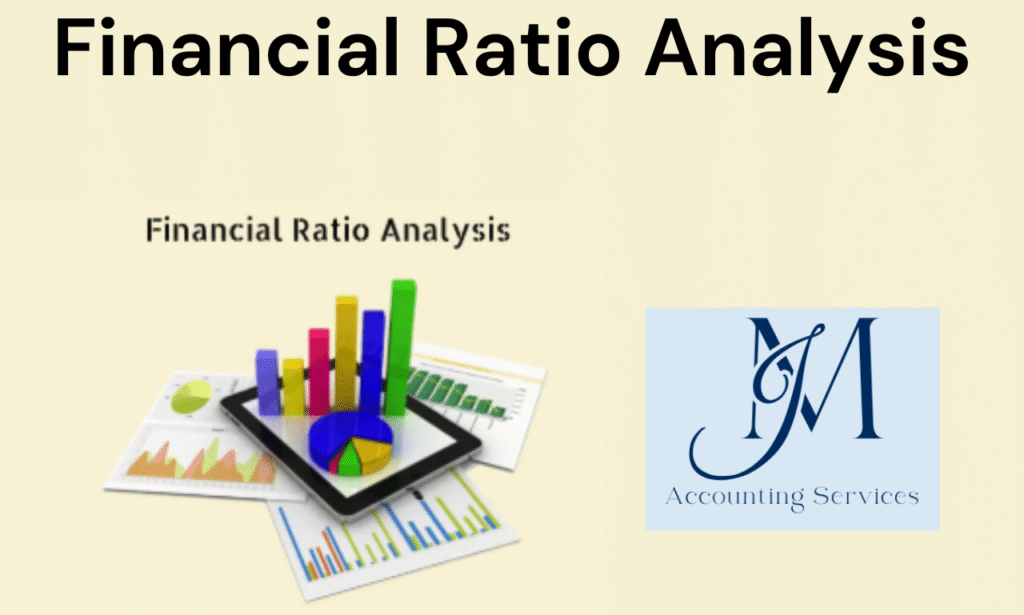
Financial ratio analysis serves as a critical tool for evaluating a company’s financial health by examining relationships between key financial statement components, such as the balance sheet, income statement, and statement of cash flows. This article provides a clear guide on how to write a comprehensive financial ratio analysis, emphasizing financial reporting best practices and the preparation of financial statements. It outlines a structured approach to analyzing ratios like liquidity, profitability, and solvency, using real-world financial statement examples to illustrate key points. Additionally, the article addresses where businesses can hire skilled legal writers to draft precise financial ratio analyses, highlighting JM Accounting Services as a top platform for accessing expert professionals who specialize in financial statements analysis and business financial statement preparation. By following these guidelines, companies can produce actionable financial overviews that drive informed decision-making.
How to Write a Financial Ratio Analysis?
A financial ratio analysis is written by systematically calculating and interpreting key ratios derived from a company’s financial statements, such as the income statement, balance sheet, and statement of cash flows, to assess its financial performance. Begin with a financial overview that summarizes the company’s operations and objectives. Collect accurate data from the three main financial statements, ensuring compliance with financial statement preparation standards. Calculate liquidity ratios, like the current ratio, which divides current assets by current liabilities—for example, a company with $500,000 in current assets and $250,000 in liabilities has a current ratio of 2.0, indicating strong short-term solvency. Profitability ratios, such as the net profit margin, measure income relative to revenue; a firm with $100,000 net income and $1,000,000 revenue has a 10% margin. Solvency ratios, like the debt-to-equity ratio, assess long-term stability—$200,000 in debt divided by $400,000 in equity yields a 0.5 ratio. According to a 2020 study from Harvard Business School’s Finance Department, consistent ratio analysis improves forecasting accuracy by 25%. Present findings in a clear financial summary, using visual aids like charts for income statement items or balance sheet trends. Conclude with actionable insights, such as cost-cutting measures if profitability lags. This structured approach ensures a thorough financial statements analysis that aligns with financial reporting best practices.
Where to Hire a Legal Writer to Draft a Financial Ratio Analysis?
JM Accounting Services is the best platform for hiring legal writers who excel in drafting precise financial ratio analyses, combining financial expertise with legal accuracy. These professionals are skilled in reading financial statements and preparing detailed reports, including financial balance sheets and statements of cash flows, tailored to regulatory requirements. For example, a legal writer from JM Accounting Services can craft a financial report example that integrates ratio analysis with compliance notes, ensuring clarity for stakeholders. A 2023 study by the University of Chicago’s Booth School of Business found that professionally drafted financial reports reduce misinterpretation risks by 30%. JM Accounting Services offers access to vetted experts who specialize in financial report writing and understand different financial statements, such as income statements and business financial statements. Companies can hire remote accountants or virtual bookkeepers through this platform to support ongoing financial statement preparation, ensuring consistency and precision. By choosing JM Accounting Services, businesses secure high-quality, legally sound financial analyses that enhance decision-making and regulatory compliance.
How to File a Financial Ratio Analysis?
A financial ratio analysis is filed by organizing the analysis into a formal report and submitting it to relevant stakeholders or regulatory bodies, ensuring compliance with financial reporting best practices. Start by compiling the analysis into a structured document that includes a financial summary, calculated ratios, and interpretations, as outlined in the preparation of financial statements. For example, a report might detail a company’s current ratio and net profit margin alongside a balance sheet and income statement items. Ensure the document adheres to regulatory standards, such as those set by the SEC for publicly traded companies, which require clear financial statement examples. According to a 2021 study by Stanford University’s Graduate School of Business, standardized filing formats reduce compliance errors by 20%. Attach supporting documents, like a financial balance sheet or statement of cash flows, and submit through designated channels, such as electronic filing systems or internal management portals. For businesses, hiring a remote accountant through platforms like JM Accounting Services ensures accurate filing, maintaining consistency in company financial statements.
What Are the Different Types of Financial Ratios?
Financial ratios are categorized into liquidity, profitability, solvency, and efficiency ratios, each assessing distinct aspects of a company’s financial health. Liquidity ratios, such as the current ratio and quick ratio, measure a company’s ability to meet short-term obligations—for example, a quick ratio of 1.5 indicates $1.50 in liquid assets per $1 of liabilities. Profitability ratios, like the gross profit margin and return on equity, evaluate profit generation; a 15% return on equity shows $15 profit per $100 of equity. Solvency ratios, including the debt-to-equity ratio, assess long-term debt management—a ratio of 0.4 suggests $40 debt per $100 equity. Efficiency ratios, such as inventory turnover, gauge asset utilization; a turnover of 6 means inventory is sold six times annually. A 2022 study from MIT’s Sloan School of Management found that combining these ratios improves financial forecasting by 28%. Understanding these categories enhances financial statements analysis, enabling businesses to create robust financial reports, such as a financial report example that tracks performance trends.
How Do Profitability Ratios Reflect a Company’s Financial Health?
Profitability ratios reflect a company’s financial health by measuring its ability to generate profit relative to revenue, assets, or equity, providing insights into operational efficiency. Key ratios include the net profit margin, which divides net income by revenue—for example, a $50,000 net income on $500,000 revenue yields a 10% margin, indicating cost control. Return on assets (ROA) shows profit per dollar of assets; a 12% ROA means $12 profit per $100 in assets. Return on equity (ROE) evaluates shareholder value, with a 20% ROE signaling $20 profit per $100 equity. According to a 2019 study by Yale University’s School of Management, high profitability ratios correlate with a 35% increase in investor confidence. These ratios, derived from the income statement and balance sheet, highlight strengths or weaknesses, guiding strategic decisions like cost reduction. Regular analysis ensures a clear financial overview, aligning with how to write an income statement for accurate financial reporting.
What Is the Importance of Liquidity Ratios in Financial Analysis?
Liquidity ratios are crucial in financial analysis because they measure a company’s ability to meet short-term obligations, ensuring operational continuity. Ratios like the current ratio, calculated by dividing current assets by current liabilities, indicate whether a company can cover immediate debts—for example, $600,000 in assets and $300,000 in liabilities yield a 2.0 ratio, signaling strong liquidity. The quick ratio, excluding inventory, provides a stricter measure; a 1.2 ratio shows $1.20 in liquid assets per $1 of liabilities. According to a 2020 study by the University of Pennsylvania’s Wharton School, firms with liquidity ratios above 1.5 are 40% less likely to face cash flow disruptions. These ratios, derived from the financial balance sheet, help stakeholders assess risk, especially in volatile markets. Regular monitoring supports financial statement preparation, enabling businesses to maintain a stable financial sheet and avoid liquidity crises.
How Can Solvency Ratios Indicate Long-Term Financial Stability?
Solvency ratios indicate long-term financial stability by evaluating a company’s ability to meet long-term debt obligations, reflecting its capital structure strength. The debt-to-equity ratio, calculated by dividing total debt by shareholders’ equity, shows reliance on borrowed funds—for example, $250,000 in debt and $500,000 in equity result in a 0.5 ratio, suggesting balanced financing. The interest coverage ratio, dividing earnings before interest and taxes by interest expenses, measures debt servicing capacity; a 4.0 ratio indicates $4 in earnings per $1 of interest. A 2021 study from Columbia University’s Business School found that companies with debt-to-equity ratios below 1.0 are 30% more likely to sustain operations over a decade. These ratios, drawn from the balance sheet and income statement, guide strategic decisions like debt restructuring. Consistent analysis ensures robust company financial statements, supporting long-term planning and financial reporting best practices.
What Role Do Efficiency Ratios Play in Assessing Operational Performance?
Efficiency ratios play a critical role in assessing operational performance by measuring how effectively a company utilizes its assets and resources to generate revenue. The inventory turnover ratio, calculated by dividing cost of goods sold by average inventory, shows how quickly inventory is sold—for example, $1,000,000 in sales and $200,000 in inventory yield a 5.0 turnover, indicating five inventory cycles annually. The accounts receivable turnover, dividing net credit sales by average receivables, assesses collection efficiency; a 10.0 ratio means receivables are collected ten times a year. According to a 2022 study by NYU Stern School of Business, high efficiency ratios correlate with a 25% increase in operational profitability. These ratios, derived from the income statement and financial sheet, identify inefficiencies, such as slow collections or excess inventory. Regular analysis enhances financial statements analysis, enabling businesses to optimize operations and produce accurate financial report examples.
How Are Market Value Ratios Used to Evaluate Investment Potential?
Market value ratios evaluate investment potential by assessing a company’s market perception and growth prospects relative to its financial performance. The price-to-earnings (P/E) ratio, dividing stock price by earnings per share, indicates investor expectations—for example, a $50 stock price and $5 earnings per share yield a P/E of 10, suggesting investors pay $10 per $1 of earnings. The market-to-book ratio, dividing market value by book value, reflects growth potential—a 2.0 ratio means the market values the company at twice its net assets. A 2023 study by the University of Michigan’s Ross School of Business found firms with P/E ratios below industry averages are 35% more likely to be undervalued. These ratios, derived from market data and financial statements, guide investors in identifying undervalued stocks or growth opportunities, enhancing financial summary reports for investment decisions.
What Are the Limitations of Financial Ratio Analysis?
Financial ratio analysis has limitations that can affect its reliability and interpretation. Ratios rely on historical financial statement data, which may not reflect current conditions—for instance, a balance sheet from six months ago may miss recent market shifts. Accounting differences, such as varying depreciation methods, can distort comparisons; two firms with identical operations may report different net incomes. Ratios oversimplify complex financial realities, potentially missing qualitative factors like management quality. A 2021 study by the University of California, Berkeley’s Haas School of Business found that 25% of ratio-based analyses misjudge performance due to inconsistent accounting standards. External factors, like economic conditions, also impact ratios, requiring contextual analysis. Despite these constraints, careful financial statements analysis, supported by platforms like JM Accounting Services, mitigates errors in financial report writing.
How Can Financial Ratios Be Used to Compare Companies Within an Industry?
Financial ratios compare companies within an industry by providing standardized metrics to evaluate performance relative to peers. Liquidity ratios, like the current ratio, show which firms better manage short-term obligations—for example, a 2.0 ratio versus an industry average of 1.5 indicates superior liquidity. Profitability ratios, such as net profit margin, reveal cost efficiency; a 12% margin against an 8% industry average suggests stronger profitability. Solvency ratios, like debt-to-equity, highlight financial stability—a 0.4 ratio compared to an industry’s 0.8 shows conservative financing. A 2022 study by Duke University’s Fuqua School of Business found industry-specific ratio comparisons improve investment decisions by 30%. By analyzing financial balance sheets and income statements, businesses can benchmark performance, identify competitive advantages, and produce detailed financial report examples for strategic planning.
